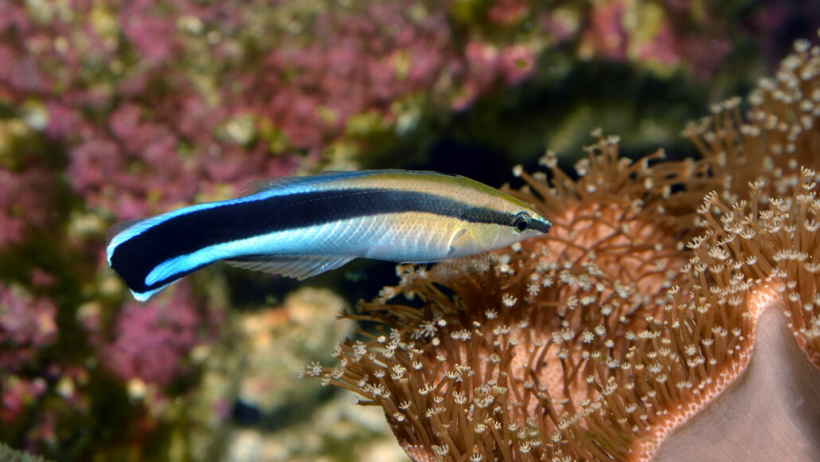Based on a recent scientific report, certain fish can recognize their reflection in photos and mirrors, a trait previously thought to be exclusive to highly intelligent species such as humans and chimpanzees. This discovery suggests that self-awareness may be more widespread among animals than previously believed.
To animal sociologist Masanori Kohda of Osaka Metropolitan University in Japan, the notion that animals with larger brains are more intelligent than those with smaller brains is widely accepted. However, Kohda suggests that this assumption may need to be reevalua ted, as his previous research has shown that Bluestreak cleaner wrasses are capable of passing the mirror test, as reported by Science News.
This test, which is a controversial measure of cognitive abilities, involves exposing an animal to a mirror and then marking its body to see if it notices the mark on its reflection and tries to touch it. Only a limited number of species, such as chimpanzees and other great apes, dolphins, elephants, and magpies, with large brains, have previously passed this test.
Cleaner Fish on a Mirror Test
Following the recent study, cleaner fish that passed the mirror test was able to identify their faces in still photos and distinguish them from the faces of other cleaner fish. This implies that the fish similarly recognize themselves to humans, who are believed to form a mental image of their face. The research was conducted by Masanori Kohda and colleagues and was published in the Proceedings of the National Academy of Sciences on February 6. Primatologist Frans de Waal of Emory University in Atlanta, who was not involved in the research, called the study "incredible" and "truly remarkable."
Frans de Waal emphasized that failing the mirror test does not necessarily indicate a lack of self-awareness. Despite this, researchers have had difficulty explaining why some species with known complex cognitive abilities, such as monkeys and ravens, have failed the test. The test's applicability to species that rely more on scent, like dogs, or are not bothered by marks on their bodies, like pigs, has also been questioned.
The fact that a small fish like the cleaner fish can pass the test despite these mixed results in other animals makes the findings even more remarkable. In their earlier studies, published in 2019 and 2022, Kohda and his team observed wild-caught cleaner fish in separate tanks exposed to mirrors for a week. They then applied brown dye under the fish's scales, simulating the appearance of parasites. When the marked fish saw their reflection in the mirror, they started striking their throats on rocks or sand in the tank, seemingly attempting to remove the marks.

Bluestreak cleaner wrasse, Labroides dimidiatus, can recognize photos of themselves, suggesting that they have self-awareness.
ALSO READ: Massive Tuna Fish Commits Suicide After Getting Agitated With Flash Photography [WATCH]
Aware Aquatic Species
In the new study, 10 fish that had passed the mirror test were presented with a photo of their face and a photo of a cleaner fish face they didn't recognize. All of the fish displayed aggressive behavior towards the unfamiliar photo, as if it were a stranger, but showed no aggression towards the photo of their face. Another eight fish that had spent a week with a mirror but were not marked beforehand were then shown a photo of their face with a brown mark on the throat. Six of these fish began to scrape their throats, just like the fish that passed the mirror test but did not exhibit the same behavior when shown a photo of another fish with a mark.
Scientists believe that animals that recognize their reflection in mirrors initially learn to identify themselves by noticing that the movement of the animal in the mirror corresponds to their movements. As the cleaner fish were capable of recognizing their faces in still photos, they, and potentially other animals that have passed the mirror test, might be able to identify themselves by creating a mental image of their face that they can compare to what they see in mirrors or photos, the researchers suggest.
Jennifer Vonk, a comparative cognitive psychologist from Oakland University in Rochester, Michigan who did not participate in the study, said that it is a great next step but more research is needed to determine what is happening in the mind of a nonverbal creature like a fish. Kohda's laboratory has plans for additional experiments to further investigate the brain of cleaner fish and to apply the new photo-recognition method to another commonly studied fish species, the three-spined stickleback.
RELATED ARTICLE: Mysterious Stream of Thousands of Suffocating Fish Filmed Crawling Along the Sand: How Could This Have Happened?
Check out more news and information on Fish in Science Times.














